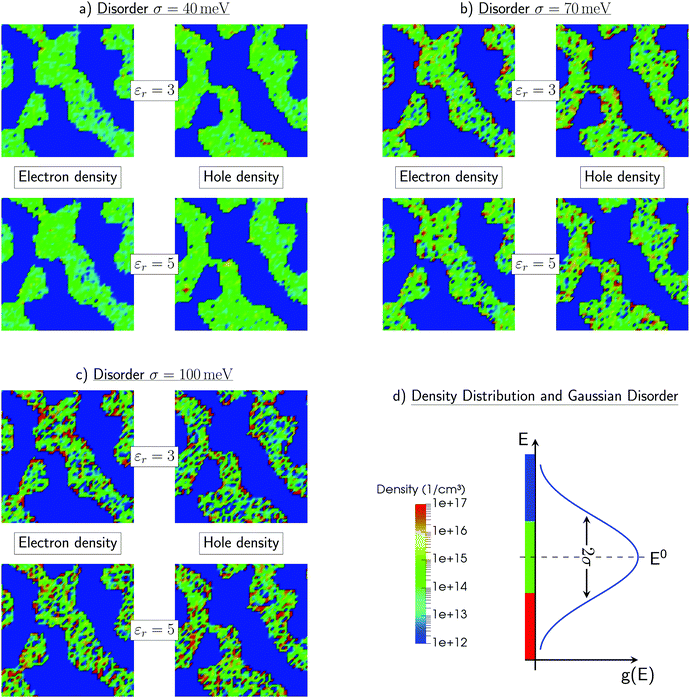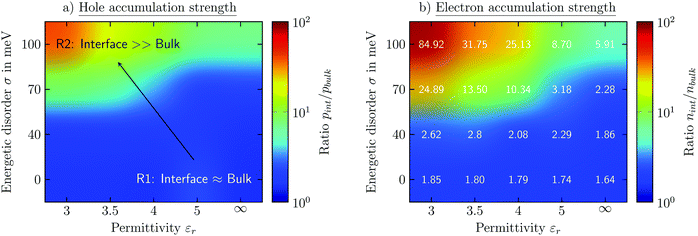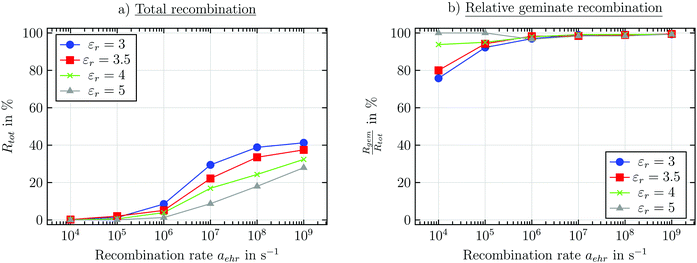 Open Access Article
Open Access ArticleCreative Commons Attribution 3.0 Unported Licence
Correction: Influence of permittivity and energetic disorder on the spatial charge carrier distribution and recombination in organic bulk-heterojunctions
Tim
Albes
 * and
Alessio
Gagliardi
*
* and
Alessio
Gagliardi
*
Department of Electrical and Computer Engineering, Technical University of Munich, Karlstr. 45, 80333 Munich, Germany. E-mail: tim.albes@tum.de
First published on 17th May 2019
Abstract
Correction for ‘Influence of permittivity and energetic disorder on the spatial charge carrier distribution and recombination in organic bulk-heterojunctions’ by Tim Albes et al., Phys. Chem. Chem. Phys., 2017, 19, 20974–20983.
1 Summary
The authors regret a mistake in their previously published paper and would like to communicate a correction.Throughout the manuscript, the values for the energetic disorder σ that have been investigated were stated to be 0 meV, 30 meV, 50 meV, and 70 meV. Due to a mistake in the implementation, these values need to be rescaled by a factor of  and therefore correspond to 0 meV, 42.4 meV, 70.7 meV, and 99.0 meV, respectively. For readability, we will refer to them as 0 meV, 40 meV, 70 meV, and 100 meV in the following.
and therefore correspond to 0 meV, 42.4 meV, 70.7 meV, and 99.0 meV, respectively. For readability, we will refer to them as 0 meV, 40 meV, 70 meV, and 100 meV in the following.
The results in the original manuscript are correct as presented but the values for the disorder need to be re-labeled throughout the text and in the figures. This correction does not change the overall implications and conclusions, namely the interface charge accumulation and the increased recombination at low permittivity εr in combination with a large energetic disorder.
2 Detailed correction
In Fig. 1, the charge carrier distribution (CCD) is shown for σ ranging from 40 meV to 100 meV; it replaces Fig. 2 of the original manuscript. The figure is identical except for the labelling of σ. The statement of the figure remains, i.e., large values of σ can make the CCD fluctuate by several orders of magnitude locally.The quantitative evaluation of interface densities vs. bulk densities is shown in Fig. 2 with the corrected axis description for σ; it replaces Fig. 3 of the original manuscript.
Fig. 4 of the original manuscript remains unchanged, but shows the absolute CCDs for σ = 100 meV instead of 70 meV.
Fig. 5 of the original manuscript shows the total recombination Rtot and corresponding relative amount of geminate recombination  for σ = 100 meV instead of σ = 70 meV. We have added the results for what should have been Fig. 5 in the original manuscript, i.e. Rtot and
for σ = 100 meV instead of σ = 70 meV. We have added the results for what should have been Fig. 5 in the original manuscript, i.e. Rtot and  at 70 meV, in Fig. 3 for an extended parameter set of the recombination rate aehr ranging between 104 s−1 and 109 s−1. It can be seen from Fig. 3a that, while Rtot is considerably smaller than at σ = 100 meV, it shows the same trend of being strongly dependent on both εr and aehr. In particular, also here the change in Rtot between slight changes of εr outweighs orders of magnitude of aehr and highlights the strong influence of the permittivity on the total recombination. At a disorder of 100 meV, values less than aehr ≈ 5 × 104 s−1 were identified at εr = 3.5 in order to obtain a sufficiently functioning device with Rtot < 25%. At 70 meV, values up to aehr ≈ 107 s−1 (corresponding to 100 ns of pair recombination time) lead to Rtot < 25%, which represent a more realistic scenario according to what is found by transient absorption spectroscopy (TAS) measurements.1 Even for recombination times of 1 ns (aehr = 109 s−1), the device is still reasonably functioning with 37.47% of all charges recombining. From Fig. 3b it is evident that also at σ = 70 meV geminate recombination clearly dominates over nongeminate recombination and cannot be neglected as a major loss mechanism.
at 70 meV, in Fig. 3 for an extended parameter set of the recombination rate aehr ranging between 104 s−1 and 109 s−1. It can be seen from Fig. 3a that, while Rtot is considerably smaller than at σ = 100 meV, it shows the same trend of being strongly dependent on both εr and aehr. In particular, also here the change in Rtot between slight changes of εr outweighs orders of magnitude of aehr and highlights the strong influence of the permittivity on the total recombination. At a disorder of 100 meV, values less than aehr ≈ 5 × 104 s−1 were identified at εr = 3.5 in order to obtain a sufficiently functioning device with Rtot < 25%. At 70 meV, values up to aehr ≈ 107 s−1 (corresponding to 100 ns of pair recombination time) lead to Rtot < 25%, which represent a more realistic scenario according to what is found by transient absorption spectroscopy (TAS) measurements.1 Even for recombination times of 1 ns (aehr = 109 s−1), the device is still reasonably functioning with 37.47% of all charges recombining. From Fig. 3b it is evident that also at σ = 70 meV geminate recombination clearly dominates over nongeminate recombination and cannot be neglected as a major loss mechanism.
At last, in order to link σ and εr on the device performance, Table 1 shows the effect of σ and εr at aehr = 5 × 104 s−1 on the short-circuit current jsc with the corrected values for σ = 0 meV, 40 meV, 70 meV, 100 meV; it replaces Table 1 of the original manuscript. We have furthermore added the dependence of jsc on σ and εr for a larger recombination rate of aehr = 107 s−1 in Table 2, in order to show the effect at smaller recombination times. The trend is equivalent (i.e. the anti-correlation of interface accumulation strength and jsc) but more pronounced, as a larger aehr induces faster and therefore more recombination.
| σ (meV) | ε r | ||||
|---|---|---|---|---|---|
| 3 | 3.5 | 4 | 5 | ∞ | |
| 100 | 4.62 | 5.92 | 6.77 | 7.62 | 8.21 |
| 70 | 7.24 | 7.59 | 7.33 | 7.65 | 8.11 |
| 40 | 7.31 | 7.44 | 7.52 | 7.71 | 8.24 |
| 0 | 7.53 | 7.58 | 7.65 | 7.75 | 8.36 |
| σ (meV) | ε r | ||||
|---|---|---|---|---|---|
| 3 | 3.5 | 4 | 5 | ∞ | |
| 100 | 0.95 | 2.08 | 3.24 | 5.18 | 8.08 |
| 70 | 5.08 | 5.72 | 6.15 | 6.85 | 8.10 |
| 40 | 7.45 | 7.51 | 7.54 | 7.69 | 8.13 |
| 0 | 7.47 | 7.51 | 7.66 | 7.86 | 8.35 |
There are no qualitative changes in the conclusions of the paper. However, considering the corrected results, we can conclude more suitable recombination rates around aehr ≈ 107 s−1 at an energetic disorder of 70 meV and a permittivity of εr = 3.5.
Acknowledgements
The authors thank Waldemar Kaiser for spotting the mistake.The Royal Society of Chemistry apologises for these errors and any consequent inconvenience to authors and readers.
References
| This journal is © the Owner Societies 2019 |



